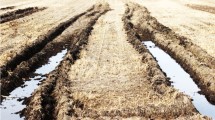Abstract
Drastic changes in the sugar trade agreements call for urgent management adaptation to ensure the economic sustainability of the Mauritian sugarcane sector. In-line with improvement being made at the level of labour and machine efficiency, an extension of the harvest season is being envisaged. It has been noted that cane harvested early in the season is characterized by low sucrose contents and high levels of impurities resulting in less efficient manufacturing processes. While investments are being made in the breeding of early-maturing varieties, the latter are not expected to become available in the near future. In view of providing a more rapid solution, the option of utilizing the knowledge acquired through three decades of ripener treatment was investigated and an economic feasibility study conducted. Past trial data showed that the major proportion of biomass accumulation is completed by the end of May in Mauritius and that improvement in sucrose content from artificial ripening can reach an average 1.5 units early in the season, then decreasing to 0.65 by beginning of September. Gross returns of the operation under the assumption of one unit improvement in industrially-recoverable sucrose content for crops with cane yields ranging from 60 to 120 t ha−1 would be from MUR 6 038 ha−1 to MUR 14 376 ha−1 at a sugar price of MUR 14 146 t−1, from MUR 4 421 ha−1 to MUR 11 892 ha−1 at a sugar price of MUR 12 785 t−1, and from MUR 1 373 ha−1 to MUR 6 847 ha−1 at a sugar price of MUR 9 539 t−1. Thus, it is more advantageous to treat crops with high biomass accumulating potential. At industry level, under the worse case scenario of lowest sugar price expected to prevail after the implementation of the 36% cut in October 2010 and the treatment of only between 30% to 60% of the cane area under corporate management over the first 14 weeks of harvest, the exercise showed that ripener application is indeed profitable, the return to investment being more than one. Thus, the area to be treated would range from 5971 ha to 9952 ha depending on the proportion of the estate to be treated and the marginal returns would range from MUR 23 million to MUR 39 million, and the ratio of return to investment would exceed one.
Similar content being viewed by others
References
Government of Mauritius. Ministry of Agro-Industry & Fisheries (2006) Multi Annual Adaptation Strategy — Action Plan 2006–2015: Safeguarding the future through consensus. Port Louis: Ministry of Agro-Industry & Fisheries. 90 pp.
Mauritius Sugar Industry Research Institute (2003) Artificial ripening of the sugar cane. Recommendation Sheet No. 135. MSIRI, Reduit, Mauritius.
Moothy V and Nayamuth R (1999) The use of ripeners at Rose Belle SE. Révue Agricole et Sucrière de L’Ile Maurice 78(1): 45–49.
MSIRI. (2007). MSIRI Annual Report 2007
Payandi-Pillay K, Travailleur C, Goolamhossen M and Nayamuth R (1999) Adoption of artificial ripening by the Mauritian sugar cane growers. Révue Agricole et Sucrière de L’Ile Maurice 78(1): 66–74.
Soopramanien GC (1999) Cane ripener research and development in Mauritius: a historical review. Révue Agricole et Sucrière de L’Ile Maurice 78(1): 2–9.
Author information
Authors and Affiliations
Corresponding author
Rights and permissions
About this article
Cite this article
Cheeroo-Nayamuth, B.F., Nayamuth, A.R.H. Centralisation of sugarcane milling operations: matching agronomics with economics. Sugar Tech 10, 293–297 (2008). https://doi.org/10.1007/s12355-008-0052-7
Received:
Accepted:
Published:
Issue Date:
DOI: https://doi.org/10.1007/s12355-008-0052-7




